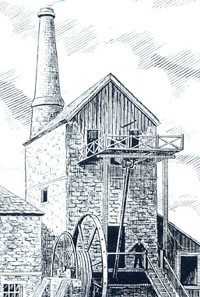Landscape, History and Wildlife
Landscape
Wheal Basset Farm is of significant landscape interest. Wheal Ellen
Engine House can be viewed from ‘Old Basset Cottage’ its
construction being of particular interest in that it has a castellated
chimney which could be unique. The mine produced tin and closed in 1839.
Mining to the south side of the valley including ‘Old Basset Mine’
which closed in 1810 was for tin whereas the north side of the valley
was for copper. Past industrial activity combined with agricultural use
has developed a characteristic landscape of old mine workings, small
fields, wet meadows, wet woodland, mixed scrub, Cornish hedgerows and
lowland heath. The Porthtowan valley was mined for tin from the late
17th to the early 19th century. Over this period the farm developed to
service the requirements of the miners from Wheal Ellen. Stone quarried
from the farm was used in the construction of the mine buildings, out
houses, Cornish hedgerows and stiles.
The Cornish hedgerows are of archaeological interest, displaying a
number of different styles and types. To the north, stone has been faced
into the hill slope, to the south the hedgerows display standards of oak
and ash associated with hawthorn, gorse, blackthorn and bramble.
Hedgerows are principally of the stone-faced earth bank type, topped
with wind sculpted scrub.
History
 17th century maps show Wheal Basset Farm being in existence at that time. The original farm house being the holiday cottage (the chimney stack remains in the main bedroom). The Cornwall Archaeological Unit has suggested that until the 18th century the land would have been utilised for rough grazing and the collection of fuel. During the 18th and 19th centuries deep shaft mining was carried out. Many of the mine workings on and around Wheal Basset Farm remain. Tin streaming was practiced along the banks of the river. Many ‘stannery’ stones remain; it has been suggested that they mark individual claims at regular intervals along the river.
17th century maps show Wheal Basset Farm being in existence at that time. The original farm house being the holiday cottage (the chimney stack remains in the main bedroom). The Cornwall Archaeological Unit has suggested that until the 18th century the land would have been utilised for rough grazing and the collection of fuel. During the 18th and 19th centuries deep shaft mining was carried out. Many of the mine workings on and around Wheal Basset Farm remain. Tin streaming was practiced along the banks of the river. Many ‘stannery’ stones remain; it has been suggested that they mark individual claims at regular intervals along the river.
The present Wheal Basset Farm House was in existence by the first half of the 19th century, as indicated on the 1809 OS map. To the south east of the farm are the remains of a settlement that was in existence by 1840 but abandoned around 1907. It is suggested that these were miners’ small holdings with associated irregular fields cut out of the heath. Further enclosure continued throughout the late 19th and early 20th century.
Wildlife
The farm is of nature conservation interest with a variety of habitat types including wet grassland, woodland, wet woodland, Cornish hedgerows and lowland heath.
The north eastern end of the farm was designated as a Wildlife Site in March 1980. Wildlife Sites (Cornwall Nature Conservation Sites) are recognised by the Cornwall Wildlife Trust as being of at least county significance for nature conservation. The designation at Wheal Basset Farm includes areas of unimproved grassland and lowland heath which is recognised as being of national and international importance.
A number of species have been identified within the lowland heath at Wheal Basset Farm which include heather Calluna
vulgaris, bell heather Erica cinerea, tormentil Potentilla
erecta, western gorse Ulex gallii, red fescue Festuca
rubra, purple moor-grass Molinia caerulea, wood sage Teucrium
scorodonia, European gorse Ulex europaeus and broom Sarothamnus
scoparius. Within the heath scattered birch Betula pendula, holly Ilex
aquifolium and scrub oak Quecus spp. are locally frequent.
A number of interesting grassland species are found within the unimproved grassland, which include yellow
bartisa Parentucellia viscosa, self heal Prunella vulgaris, black knapweed
Centaurea nigra, sweet vernal grass Anthoxanthum ordoratum, Yorkshire fog
Holcus lanatus, velvet bent Agrostis canina, bristle-leaved bent
Agrostis setacea and silverweed Potentilla anserina.
The woodland to the southeast of the farm is composed of a mixture of trees planted within the last thirty to forty years, with a few mature standards that pre-date this period. To the northeast of the woodland a public footpath runs from the main road ascending in a westerly direction through the woodland from where it joins a track to the south.
Bird species of interest include Skylark, Barn Owl, Buzzard, Peregrine Falcon and Night Jar. These are species as detailed within Cornwall’s Biodiversity Action Plan.